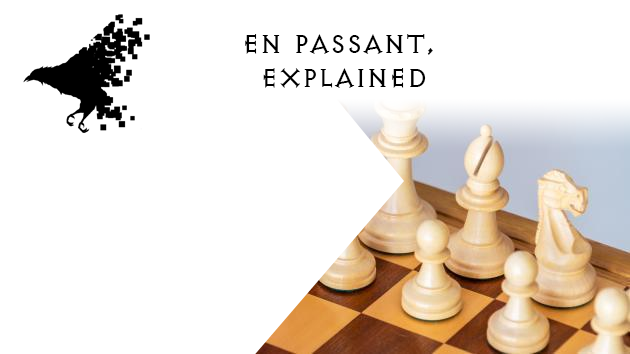
What is the en passant rule in chess? And why is it so weird?
I can’t tell you how many times I have been accused of cheating in casual games at Starbucks or playing street hustlers in big cities. Listen, if you’re ever going to try to hustle people in chess, please save yourself from this embarrassing scenario and know the en passant rule! It’s one of three special moves in chess all players need to know about.
In chess, en passant (which means “in passing”) is a special rule that allows a pawn on the 5th rank to capture a pawn that moved past it utilizing it’s two-square first move privilege. En passant captures must be made immediately after the enemy pawn moves past it or else it forfeits its privilege to exercise the special move.

Confused? So was I when I first learned it. But stick with me, a little history actually helps understand this rule!
Chess Used to be a Spectator Sport
In the days before Netflix, chess was actually a spectator sport (“chess and chill” even sounds better). The reason it was a spectator sport was because it used to be kind of a wild, flashy game where people would execute stunning sacrifices, ridiculous tactics, and it was actually rather entertaining for the general public to watch, you know, before there was tv and radio.
Back in the days when pawns only moved one square, sometimes games could take awhile to get going. Players had to move, write down their move, hit the clock, wait. Etc. A move, even in the beginning of the game, could take a minute or two for each move. Let’s take a look at a sample game before the two-move rule was created.
So it took a full 5 moves by each player (for a total of 10 plies) to reach this position. This could have taken up to 10 minutes just to reach a position where the action begins to take shape. To combat people from dying of boredom, the 2-square rule for pawns was created to speed the game up a bit. So this is why pawns are allowed to move 2 squares, instead of one, but only on their first move (the pawn’s first move, not the player’s). Now we can get into a more interesting game much faster by allowing the pawns to move 2 spaces on their first move, rather than one.
Now let’s take a look at this same game, but sped up with the two-move rule.
Now these two games have reached the same position but the second game only took 3 moves (6 plies) as opposed to 10 plies in the first game. Almost half!
So here is the important takeaway. The spirit of the two-move rule was to speed up the game!
But that Created a Problem
It’s not uncommon for rules to be introduced into games to solve problems or to keep the spirit of the game intact. For example, the shot clock was added in basketball, because prior to the shot clock era, a great way to equalize your chances against a superior team was to just stand in the corner and hold the ball. Prior to the shot clock era, there was a game between Duke and N.C. State that ended 12-10! Boring! No one wanted to watch a player dribble a basketball for 15 straight minutes without taking a shot. Thus, the shot clock was introduced to preserve the spirit of the game.
Likewise, the two-square rule for pawns was being taken advantage of. Players started using it as a defense mechanism rather than its intended purpose, speeding up the game! How pawns skirmish affects the battlefield. A common strategy is called a pawn storm where you shove pawns into an enemy position forcing a battle. People began using the two-move pawn rule to avoid pawn skirmishes.
So, that last move by black, e5, was intended to shut down that attack and ordinarily would. If that pawn were able to safely play e5, white’s attack dies on the table. The position is locked down and there’s not much white could do. However, white kind of seized the initiative and was playing aggressive and should be rewarded by forcing black’s pawns to engage. Let’s look at that sequence of moves again, this time the en passant rule is on the table, and after black plays e5, white’s going to respond with en passant.
So, an easy way to think of the en passant rule is this. You’re able to capture a pawn en passant if you would have been able to capture the pawn if it only had moved one square, instead of two. You can memorize a set of rules and conditions for en passant, but I believe it really helps if you understand the history to galvanize the concept in your mind. That said, the following are the actual hard rules for en passant capture.
En Passant Capture Rules
- Your pawn must be its 5th rank (3 spaces ahead of its starting square).
- An adjacent enemy pawn must have passed your 5th-rank pawn utilizing its 2-square opening move.
- On your following move you may elect to capture the pawn as if it had only moved one square, by moving diagonally into the space directly behind the enemy pawn which just passed.
- If you do not exercise the en passant option on your following move, it is lost and you may not do it on subsequent moves.
A Fun Puzzle
To conclude, let’s do a fun puzzle. It’s white to move and checkmate in one. Be aware, some actual grandmasters have had trouble with this puzzle! I hope the hint is obvious.
